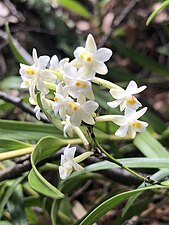| Fensham Reserve | |
|---|---|
| John Fensham Memorial Sanctuary | |
 Kahikatea in Fensham Reserve Kahikatea in Fensham Reserve | |
| Location | Wairarapa region, New Zealand |
| Nearest town | Carterton |
| Coordinates | 40°59′45″S 175°30′26″E / 40.99583°S 175.50722°E / -40.99583; 175.50722 |
| Area | 48 hectares (120 acres) |
| Established | 1957 |
| Operated by | Forest & Bird |
| Website | www |
Fensham Reserve is a protected native forest remnant in the Wairarapa region of the North Island of New Zealand, located north-west of Carterton. The area of the reserve is 48 ha (120 acres), mostly of primary forest, with 19 ha (47 acres) of regenerating forest and 3 ha (7.4 acres) of wetlands.
History
The land that is now the reserve was purchased by John Fensham in 1883, with the specific intention of preserving the forest. His daughter Ruby Fensham gifted the land to the Royal Forest and Bird Protection Society in 1957, and the title was finally settled on her death in 1978.
In 2001, the area of the Fensham Reserve was declared by Government as protected private land, under the scenic reserves section of the Reserves Act 1977.
In 2024, the Forest & Bird group of volunteers that looks after the Fensham Reserve made a proposal to Carterton District Council to allocate land associated with the defunct Belvedere Hall as the beginnings of a wildlife corridor between Fensham Reserve and the nearby Tararua Forest Park. The proposal cited concerns over the decline in biodiversity in the reserve because of its isolation in the middle of farmland.
Biodiversity
The forest in the reserve is mainly black beech, with small areas of forest types that are regionally threatened in the Wellington Region, including kahikatea – pukatea forest, and tōtara – tītoki forest. Swamp forest in the reserve includes kahikatea and other podocarps that may be 700 years old. The area of regenerating forest includes black beech, tōtara and mānuka.
The area of the Fensham Reserve makes up the majority of the Fensham Key Native Ecosystem (KNE) – a region defined by the Wellington Regional Council in the catchment of the Mangatarere Stream east of the Tararua Ranges. Land within the KNE is classified in the two highest categories of threatened ecosystems, meaning that there is less than 10-20% of original indigenous vegetation remaining on these types of land in New Zealand.
Native birds seen in the reserve include kererū, bellbird, tūī, kākā, grey warbler, fantail and kingfisher. An endangered freshwater fish, the brown mudfish (Neochanna apoda) is found in the wetland. Protected wetlands such as Fensham have high conservation value for the mudfish because it is highly threatened in other locations.

Water race
A water supply race known as the Carrington Water Race passes through the reserve. It was established over a hundred years ago, sourcing water from the Mangatarere Stream to provide freshwater for irrigation, livestock, and domestic use.
Access
The reserve is located around 4.7 km (2.9 mi) from Carterton, and is open to the public. There is a loop track through the reserve plus two cross-tracks, with boardwalks over wet areas.
Awards
In 2002, the Forest & Bird Fensham group that looks after the reserve was recognised with an award for outstanding contributions to conservation.
Gallery
- Fensham Reserve
-
 Circuit track
Circuit track
-
 Earina autumnalis inflorescence on forest floor
Earina autumnalis inflorescence on forest floor
-
 Forest scene
Forest scene
-
 Forest track
Forest track
-
 View from the lookout
View from the lookout
References
- "Destination Wairarapa: it's got it all". Dominion Post. 6 February 2019. p. 11. ProQuest 2175929472.
- "Fensham Reserve, Carterton". Forest & Bird. 9 May 2018. Archived from the original on 19 May 2024. Retrieved 25 September 2024.
- ^ Key Native Ecosystem Plan for Fensham: 2018-2021 (PDF). Greater Wellington Regional Council. August 2019. Archived (PDF) from the original on 12 July 2024. Retrieved 25 September 2024.
- ^ Pedersen, Erik (2021). "Leaving a legacy". Forest & Bird (382): 53.
- "Declaration That Private Land be Protected Private Land". New Zealand Gazette (8): 175. 25 January 2001.
- Ireland, Emily (24 September 2024). "Nature corridor proposed to boost biodiversity". The Post. Archived from the original on 26 September 2024. Retrieved 25 September 2024.
- ^ Eva, Judy (September 2020). "John Fensham Memorial Sanctuary - a lowland forest walk". Walking New Zealand (270): 12–13. Archived from the original on 27 February 2023. Retrieved 25 September 2024.
- O’Brien, Leanne K.; Dunn, Nicholas R. (August 2007). "Mudfish (Neochanna Galaxiidae) literature review" (PDF). Science for Conservation (277). Department of Conservation. Archived (PDF) from the original on 26 September 2024. Retrieved 25 September 2024.
- Fensham Group; Dixon, Melanie (April 2004). Fensham wetland monitoring guidelines (PDF). Greater Wellington Regional Council. Archived (PDF) from the original on 10 March 2023. Retrieved 25 September 2024.
- Rados, Dimitrios; Keenan, Laura (10 October 2023). Carrington Water Race: Natural and artificial water race segments' assessment (PDF). Traverse Environmental. Archived (PDF) from the original on 20 July 2024. Retrieved 25 September 2024 – via Greater Wellington Regional Council.
- "Fensham Reserve Bush Walk". www.newzealand.com. Retrieved 26 September 2024.
- "Conservation awards". Dominion Post. 9 August 2002. ProQuest 337956559.
External links
[REDACTED] Media related to Fensham Reserve at Wikimedia Commons
| Carterton District, New Zealand | |
|---|---|
| Seats: Carterton | |
| Populated places | |
| Geographic features | |
| Facilities and attractions | |
| Railway stations | |
| Government | |